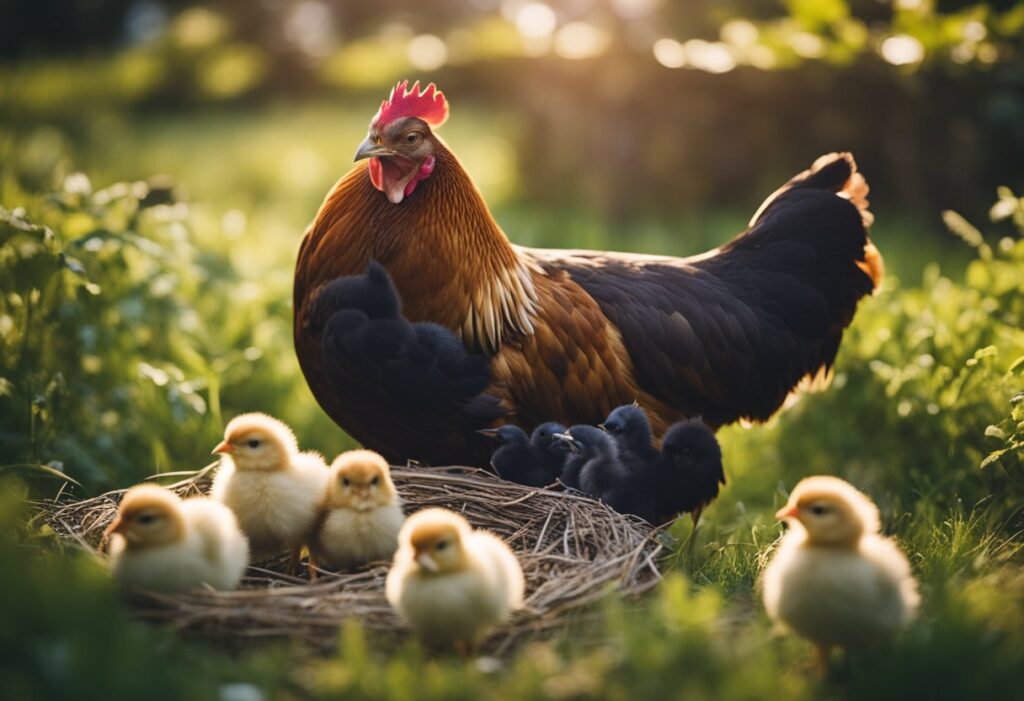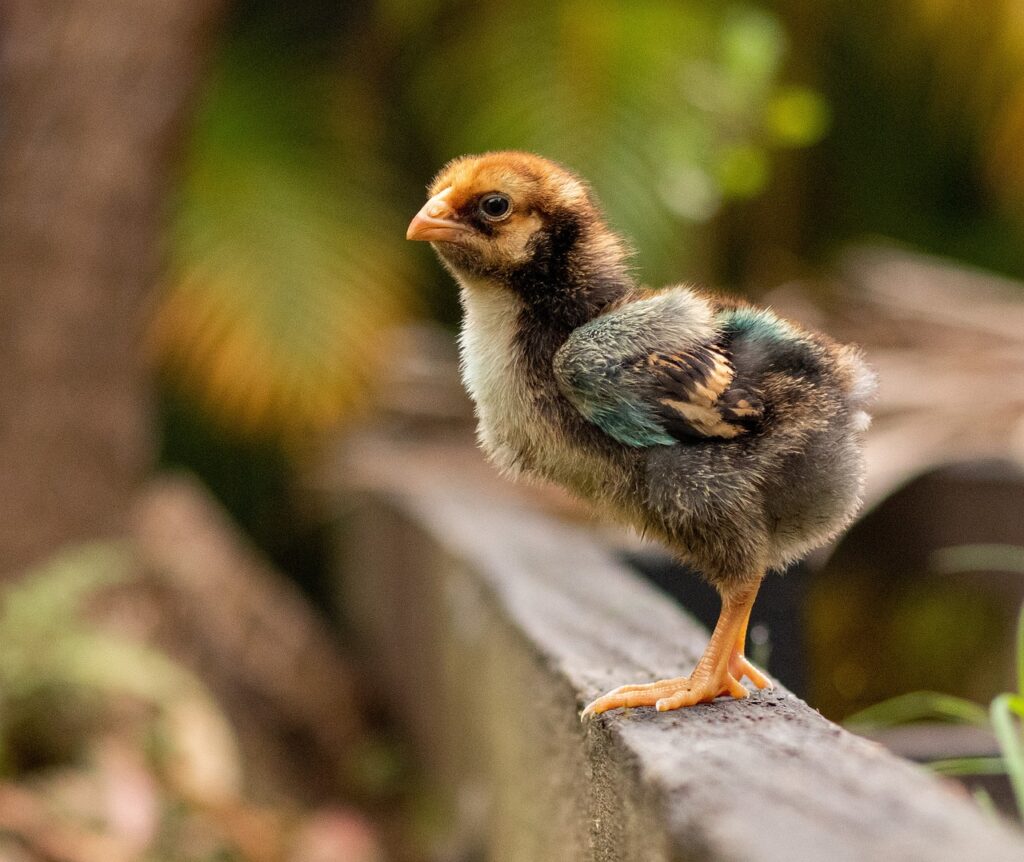Last Updated on February 1, 2024 by AwesomeChickens
Care for newborn chicks as you raise them is an endeavor that requires careful attention and knowledge to ensure the health and growth of these delicate birds. From the moment they hatch, chicks need a warm and secure environment to thrive. Temperature control is critical, as the young birds are unable to regulate their own body heat. A brooder, typically a heated enclosure, is used to provide the consistent warmth chicks need. It’s also important to maintain a clean and dry living space to protect the chicks from illnesses that can thrive in damp conditions.

Nutrition plays a vital role in the development of newborn chicks. They must have access to fresh water and appropriate starter feed that is specially formulated to meet their dietary needs. The feed contains the right balance of proteins, vitamins, and minerals to promote growth and support their developing immune systems. Chick owners should be vigilant in ensuring that food and water containers are kept clean to prevent the spread of disease.
In addition to warmth and nutrition, socialization and safety are also critical components of newborn chick care. Chicks are social animals and benefit from interaction with their flock and their human caretakers. Regular, gentle handling can help them become acclimated to people and reduce stress levels. Safety is ensured by safeguarding the brooder from potential predators and ensuring that the chicks cannot escape or injure themselves within their environment. By providing these essentials, caretakers can foster the development of healthy, robust adult chickens.
Table of Contents
Preparing the Brooder
A brooder provides a controlled environment for newborn chicks to ensure their health and safety. Proper preparation of the brooder is crucial for the chicks’ development.
Setting Up the Brooding Area
The brooding area should be secure and free of drafts. First, select a location that is sheltered and can contain the necessary equipment. It’s essential to have a space large enough for the number of chicks being cared for. Second, gather and clean all the equipment you will use, including the heat source, feeder, waterer, and thermometer. The area should be sanitized with a mild disinfectant before introducing bedding and chicks.
Maintaining Temperature
Chicks require consistent warmth, as they are unable to regulate their body temperature. A reliable heat lamp should be installed to provide a heat source, and the temperature should be monitored closely with a thermometer. Newborn chicks thrive at 95°F (35°C) for the first week, decreasing by 5°F (3°C) each week until the brooder temperature reaches the ambient temperature or chicks develop enough feathers to keep themselves warm.
| Week | Temperature |
|---|---|
| 1 | 95°F (35°C) |
| 2 | 90°F (32°C) |
| 3 | 85°F (29°C) |
| 4 | 80°F (27°C) |
| 5 | 75°F (24°C) |
| 6+ | Ambient or as needed |
Brooder Bedding Options
The bedding in the brooder should be absorbent and safe for the chicks. Pine shavings are a popular choice due to their absorbency and relative ease of cleanup. Never use cedar shavings, as the aromatic oils can be harmful to chicks. Other viable options include:
- Newspaper (shredded or whole)
- Paper towels
- Commercially available chick pads
Each bedding option must be kept dry and changed regularly to prevent mold and bacteria growth.
Feeding Your Chicks
Proper nutrition is essential for the growth and health of newborn chicks. Starting with the right feed, maintaining a consistent schedule, and providing clean water are crucial.
Choosing the Right Feed
For the first six weeks, chicks require starter feed which is high in protein, typically in the range of 18-20%. Protein is necessary for rapid growth. Starter feeds come in medicated and non-medicated varieties, with medicated feed helping to prevent coccidiosis, a common intestinal disease. After six weeks, chicks should transition to grower feed.
Here is a simple feed type table:
| Age | Feed Type | Protein Content |
|---|---|---|
| 0-6 weeks | Starter Feed | 18-20% |
| 6-20 weeks | Grower Feed | 15-17% |
| 20+ weeks | Layer Feed | 16-18% |
Feeding Schedule
Chicks should have access to feed at all times. Frequent feeding ensures optimal growth. One should check feeders at least twice a day to ensure they are not empty. Initially, it’s best to use shallow feeders to prevent chicks from soiling their food. Transition to larger feeders as they grow.
Clean Water Supply
Water is just as important as feed. Chicks should always have access to fresh, clean water. Daily changing of water is essential to avoid buildup of bacteria and contaminants. One should use waterers appropriate for the chick’s size to prevent drowning. As they grow, increasing the size of the waterers will be necessary.
Health Monitoring

Monitoring the health of newborn chicks is critical for ensuring they grow into robust birds. This section provides guidance on identifying common ailments and adhering to a vaccination schedule.
Identifying Common Ailments
Chicks can suffer from various illnesses, and early detection is vital. Pasty Butt, where droppings stick to their feathers and block the vent, is common in the first few weeks. Remediation measures include keeping the brooder clean and gently cleaning the afflicted area with a warm cloth. Symptoms of respiratory distress, such as sneezing, coughing, or labored breathing, indicate potential infections. It’s critical to separate affected chicks and consult a veterinarian.
Coccidiosis is a life-threatening intestinal disease caused by parasites. Signs include blood in the stool, lethargy, and ruffled feathers. Immediate treatment with medicated feed or water additives containing amprolium is necessary.
Vaccination Schedule
Chicks must follow a vaccination schedule to protect against common diseases. The schedule is outlined below:
| Age | Vaccine | Method |
|---|---|---|
| Day 1 | Marek’s Disease | Subcutaneous injection or in ovo before hatch |
| 7-14 days | Newcastle Disease | Eye drop or nasal spray |
| 7-14 days | Infectious Bronchitis | Eye drop or nasal spray |
| 14-21 days | Gumboro Disease | Drinking water or eye drop |
Adherence to these vaccinations is crucial for preventive health care. It’s important to keep detailed records of all vaccinations administered.
Environmental Considerations

Creating the right environment is critical for the health and growth of newborn chicks. Attention to lighting and space is essential to support their development.
Lighting Requirements
Newborn chicks require a specific range of light intensity and duration. Initially, they should have constant light exposure for at least 23 hours a day to ensure proper feeding. The recommended intensity lies between 20 to 30 lux. After the first week, the duration can be gradually reduced to simulate a natural day-night cycle.
Space Requirements
The space provided to chicks must allow for free movement and prevent overcrowding. The general rule of thumb is:
- Week 1: Provide 2.5 square inches per chick
- Week 2-4: Increase the area steadily so that each chick has 1/2 square foot by the fourth week.
Consistent monitoring and adjustments are necessary as they grow. Adequate space reduces stress and prevents behavioral issues.
Growth Milestones

In monitoring newborn chicks, it is essential to understand typical growth patterns and developmental milestones. Recognizing these indicators helps ensure proper care and development.
Physical Development
Week 1: Chicks weigh approximately 1.5 ounces at hatch and will double their weight in just one week. Feathers start as natal down.
Week 2-3: Chicks grow primary feathers on their wings, essential for temperature regulation. Weight gain continues rapidly.
Week 4-5: Body starts to fill out more, and tail feathers begin to emerge. Chicks should weigh around 4 times their initial hatch weight.
Week 6: The combs and wattles begin to develop, and secondary feathers replace the natal down. Chicks often reach a third of their adult weight.
Table 1: Average Chick Weight by Week
| Week | Average Weight (ounces) |
|---|---|
| 1 | 1.5 |
| 2 | 3 |
| 3 | 4.5 |
| 4 | 6 |
| 5 | 7.5 |
| 6 | 9-12 |
Behavioral Signs of Maturity
1-2 Weeks: Chicks will stay close to the heat source and exhibit strong instinctual pecking.
3 Weeks: As they grow, they might start testing their wings and attempt short flights.
4-5 Weeks: By this time, social hierarchies or “pecking orders” start to establish within the flock.
6 Weeks: Chicks have increased independence and demonstrate foraging behavior similar to adult chickens.




